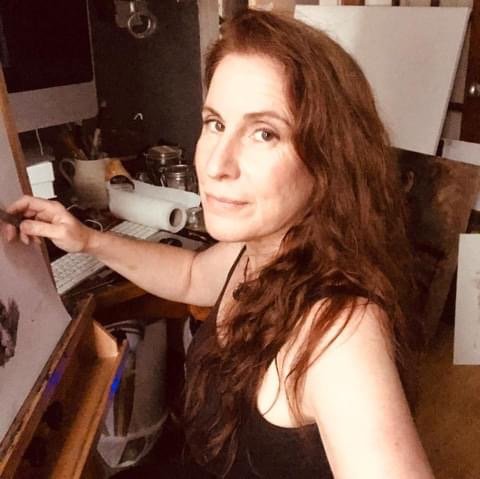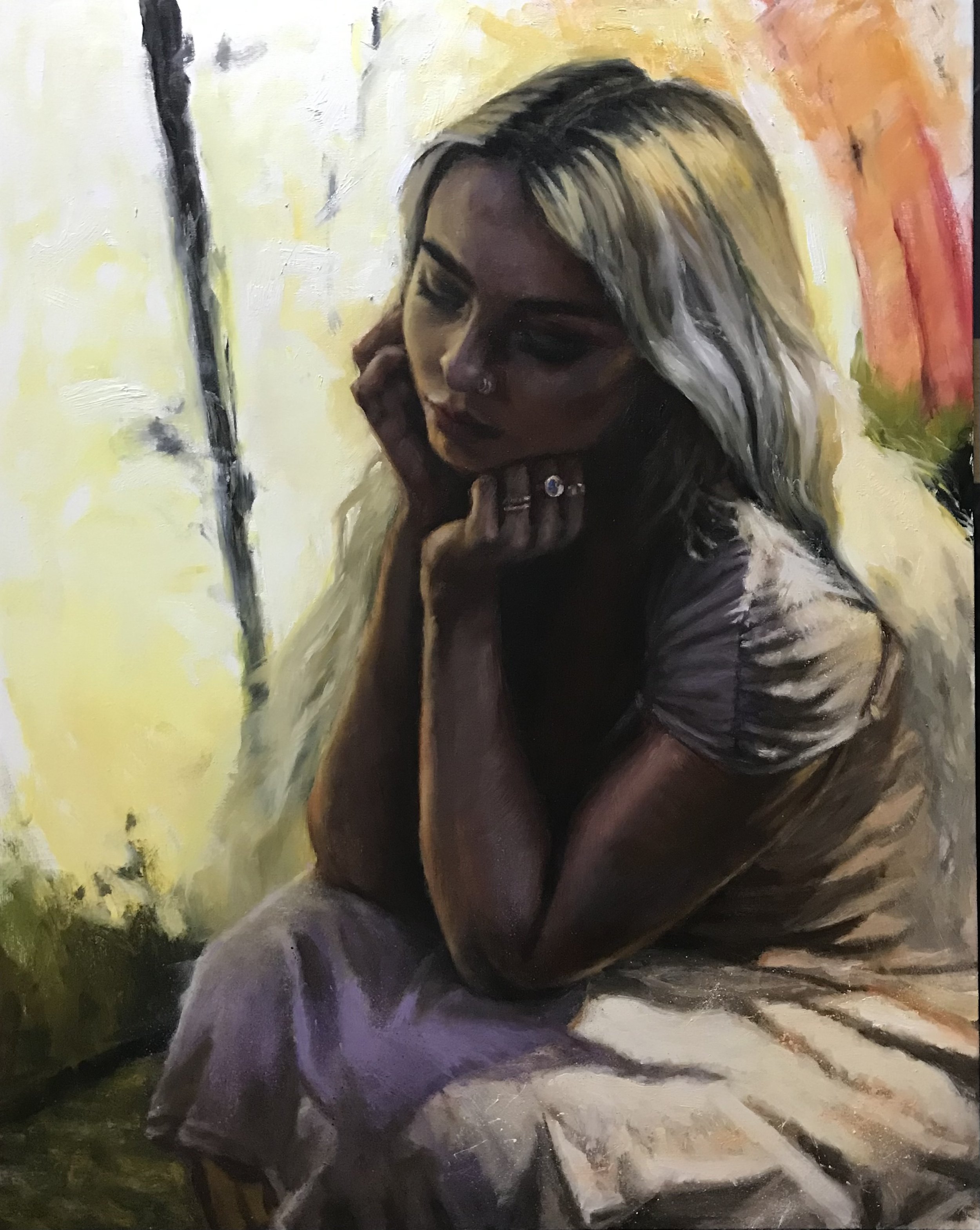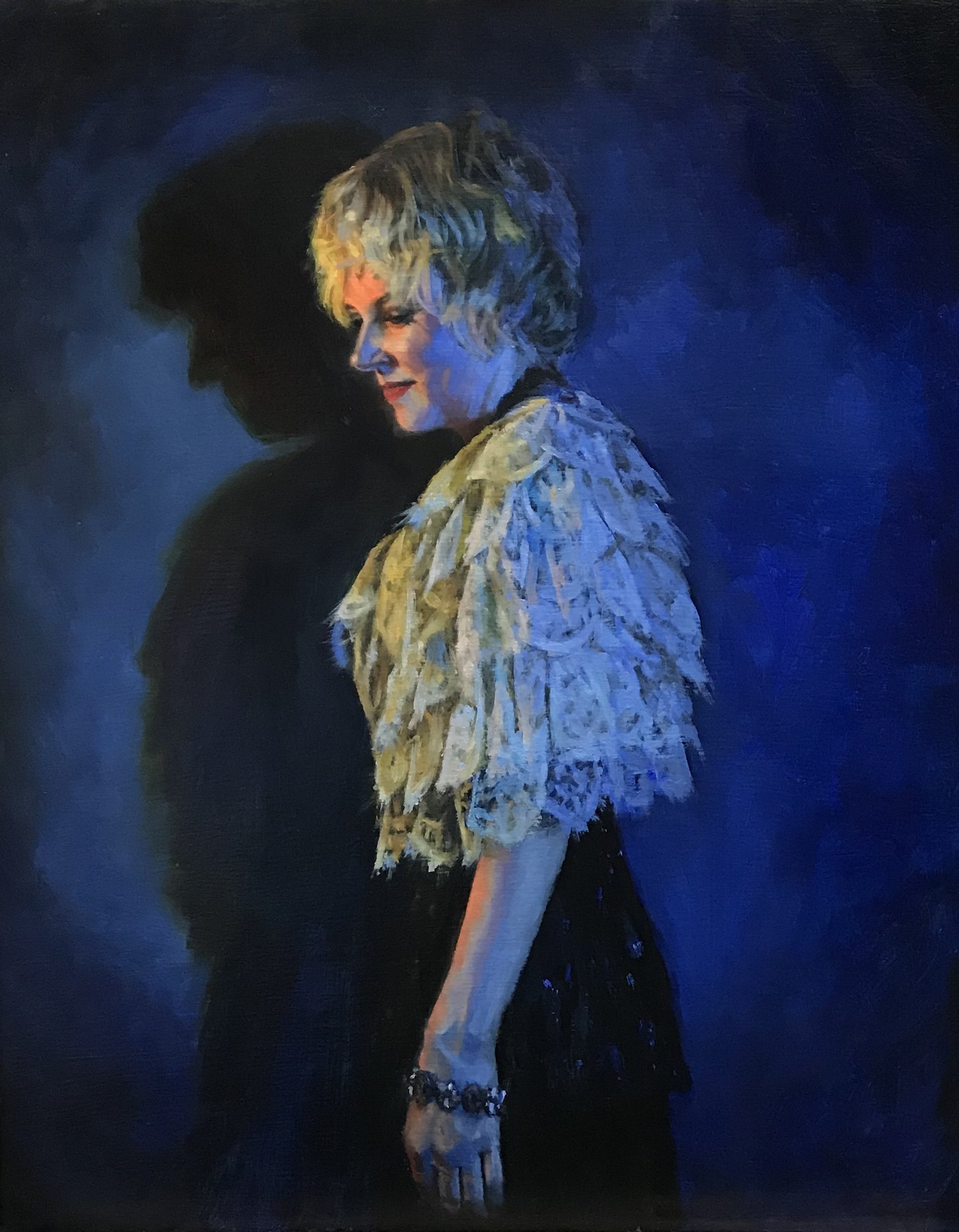ARTIST INTERVIEW: Kelly Standish
Kelly Standish
Please introduce yourself. What inspired you to pursue a career in art?
I’m a self-taught figurative artist working in oils and charcoal in the tradition of realism. Pursuing a career in art hadn’t actually been an intention of mine for most of my life. My dad paints and draws, and I’d always spent hours and hours throughout my childhood doing the same. My 20’s and 30’s were actually taken up with other things. I was a singer in bands (my first big dream), and I was working in bars and nightclubs. I went on to do some office work and a degree in English, with marriage and a daughter following on from there. A failed marriage meant that I looked to other skills as I had to try to earn an income as a single mother, and I threw myself back into my childhood joy of art. From there I just kept working at my craft, inspired by artists that I admired.
Happy Thoughts
How have narratives such as; internal struggles with self belief, been projected through your work?
Self-belief has been a huge problem, at times. I think that being self-taught naturally comes with that baggage built in, but time helps, as does meeting other artists and being picked for various art opportunities. Work wise it probably means I’ve been very hard on myself at times when I haven’t gotten things right. It can sometimes feel like I’m missing some bigger hidden ‘secret’. I realise now that there is no ‘secret’, just persistence and constant work.
You’re particularly interested in painting/drawing the human figure, why is this? What do you find compelling to paint about the body?
I started out avoiding the human figure and portraits for quite a while. I felt that they were beyond my skills and too easy to get wrong. I had to face that obstacle, as a personal challenge, simply because it’s the human element of so many paintings that draws my attention. Human beings are complex and simple at the same time, and I find it fascinating just to be one. When we see people in paintings and drawings, or any other form of art, we are connecting in a very thoughtful way with various aspects of being alive. Being alive is a unique problem and a joy. It comes with highs and lows that we carry in our minds. Nostalgia, impermanence, love, longing, desire and disappointment, permeate so much of our thoughts and can, in some small way, be represented by art.
You grew up in the coastal town of Scarborough, has this been influential to your work?
Although I’ve lived in Scarborough since 1991, I was born in Kingston Upon Thames. Most of my childhood was spent moving around, including emigrating to Australia twice! A lack of permanence and feelings of isolation were very familiar to me. I arrived in Scarborough for a one-day visit to a friend and liked it so much, I moved here. It gave me a sense of belonging for the first time in my life. Scarborough has been a great place for me to cultivate some beautiful friendships, joyous times, and to live in a town surrounded by stunning countryside and the sea.
What is the narrative behind your piece, ‘The Blue Room’? What was your process for creating this painting?
The painting ‘The Blue Room’ was painted with the idea of having an element of mystery about it. It’s almost a portrait, but not quite. There’s a movement there. There’s a story. She’s been captured in a moment where the light had made her glow. She looks demure, as though unsure as to where to look, hinting that there must be someone there observing. It’s a moment and it’s light.
How are you reflected in your artwork?
It’s always difficult for an artist to step back far enough to figure out what their artwork reflects about themselves. I would, at a guess, say that I’m preoccupied with people, relationships and connections. Memory and nostalgia and a love for beautiful moments are probably in there somewhere. I think an awful lot about the human condition and how it feels to negotiate with others and where we gain our sense of value in the world. Perhaps my art is a constant yearning, in some part, to be valued, and to value myself whilst also recognising the value of others.
In Autumn you will be featuring on Sky’s Portrait Artist of the Year. Describe your experience on the show. How did you deal with the time constraints?
Appearing on Sky Arts Portrait Artist of the Year was a very intense experience. I can honestly say that I felt like a ‘bunny in the headlights’! The time goes incredibly quickly, as I’m sure all other contestants would agree. I loved the pressure though. It totally forced me to push at my levels of focus, which is often a terrible thing to wrestle with on your own in your studio. Time wise, I had done a few practice runs to make sure that I would focus on the essentials and I’m happy with my performance on the day. I’m not allowed to say much more about it all until it airs but I can tell you that it’s a wonderful atmosphere and all those involved were genuinely lovely.
Which piece has been your favourite to work on, and why?
I don’t think I have any particular favourite pieces of work. I learn something from each piece and yet, when I’m done, it’s gone and I’m thinking about what I’m doing next. Aside from each piece I’ve done of my daughter, which are all precious to me, I don’t do favourites. I’ll leave it to others to choose their own.
If you could have a conversation with any artist, dead or alive, who would it be, and why?
There are artists, who are my heroes, that I’ve actually had conversations with, and I feel very lucky to have had those opportunities. Jeremy Mann, Casey Baugh and Nick Alm are up there as giants who I’ve admired and been lucky enough to have met. Departed heroes would include Richard Schmid, John Singer Sargent and Mary Cassatt (the wish list could go on and on, since there are so many inspiring painters).
Why do you think art is important in society?
Having recently returned from a trip to Paris, where I totally indulged in quite a few galleries, it seems to me that, although the position, reach and meaning of art in society has changed over the centuries, it is still always there. The agenda may have changed, the value of the work versus the value of the artist has certainly changed, but ultimately it seems that societies always produce art. Perhaps it’s importance simply lies in the mere fact that humans can’t seem to stop making it, feeling affinity and connections through it, and talking about it. We create it and give it it’s meaning and therefore the importance of art perhaps lies in simply being.










